Active volcanoes. Macademia nuts. Tropical fruits. These are a few of the many things that come to mind when dreaming of Hawaii. And while wine and fine tea aren’t typically included in Hawaiian day dreams, one operation is changing this and expanding the offerings of the destination.
Taking A Different Approach To Wine
The only winery on Big Island, one of only three commercial wineries in Hawaii, and the southernmost winery in the United States, Volcano Winery creates wines as unique as their titles. Featuring eight acres (3.2 hectares) of vineyards and teas, the operation is run by husband and wife duo Delwin and Marie Bothof. Despite not being Hawaiian natives and having no background in food and beverage before taking on the project, they’ve managed to not only open a thriving business, but create something truly one-of-a-kind.
“The primary thing that sets us apart is the fact we produce unique wines that use local Hawaiian fruits. We ferment the fruits into a fruit wine, then blend with grape wines,” explains Delwin. “I also believe our grapes and tea have a unique taste derived from the unique characteristics of the Volcano Region. The other thing that sets us apart from the big wineries is that we do everything by hand and therefore, more attention is given both in growing our grapes and in the production of wine. The same is true of our tea.”
In 1986, a retired veterinarian from O’ahu named Lynn “Doc” McKinney began planting Symphony grapes, believing the unusual elevation of 4,000 feet (1,219 meters) above sea level and volcanic soil of Big Island — although challenging — had the ability to create delicious wines. And when it did, a retail shop was opened in 1993 to share these homegrown flavors with the public. Doc especially loved experimenting and looking to the local land for inspiration. When Doc decided it was time to finally retire in 1999, he posted an ad selling the business. Coincidentally, it was around this time Delwin and Marie — who lived in Minnesota — were looking to buy property on Big Island. Doc loved the idea of keeping Volcano Winery a family business, and the deal was made.
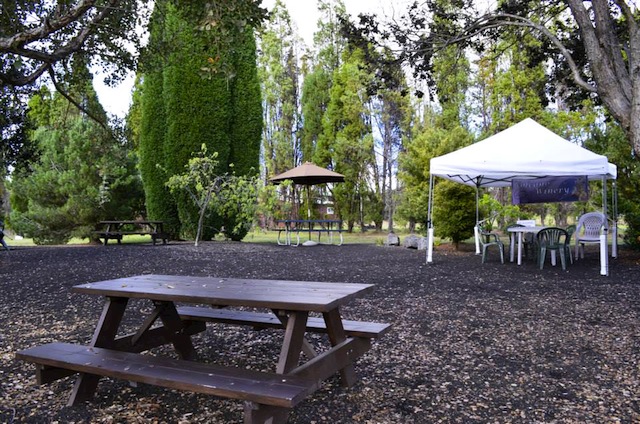
Volcano Winery picnic area
Fiery Influences
I get to meet Delwin during a visit to the vineyard and winery, where he takes me on a tour and provides the background story of Volcano Winery, which is conveniently located next to Volcanoes National Park. The December afternoon is idyllic, with warm sunshine, singing birds, rows of delicious Cayuga White and Pinot Noir vines, and a view of the active Mauna Loa, the very volcano from which the hard lava we’re standing on comes from. This condition of soil has a tendency to add a pleasant smokey quality to their wines. Picnic tables sit atop volcanic rock and under Ohia trees, an important character in Hawaiian legends.
It is believed long ago an attractive young man named Ohia was the object of affection of Pele, the goddess of the volcano. Because Ohia was already in love with a woman named Lehua, the jealous Pele transformed him into an “ugly” tree (although it is actually quite beautiful). Distraught, Lehua begged the gods to reunite her with Ohia; however, because they didn’t want to upset the fiery volcano goddess they decided to transform her into a red blossom that would bloom from the Ohia tree. Today, whenever a red Lehua blossom is picked, it rains — symbolizing the tears of Lehua as she is separated from her lover.
Another interesting tree growing in the area is the Jaboticaba, which grows a sour yet sweet fruit. While these fruits are closely related to a guava, Delwin often uses it as a grape, and plays with its flavors to create unusual wines.
“I’m not a purist when it comes to wine,” he says, smiling. “We focus on fruit wines and blend local fruits like guava and Jaboticaba, with its tart skin and sweet fruit, blended with grapes shipped in from California.”
They also make estate wines, which incorporate grapes grown onsite, including Cayuga White, Pinot Noir, Syrah and Symphony. All of their wines — as well as the teas they produce — are picked by hand, ensuring a high-quality product.
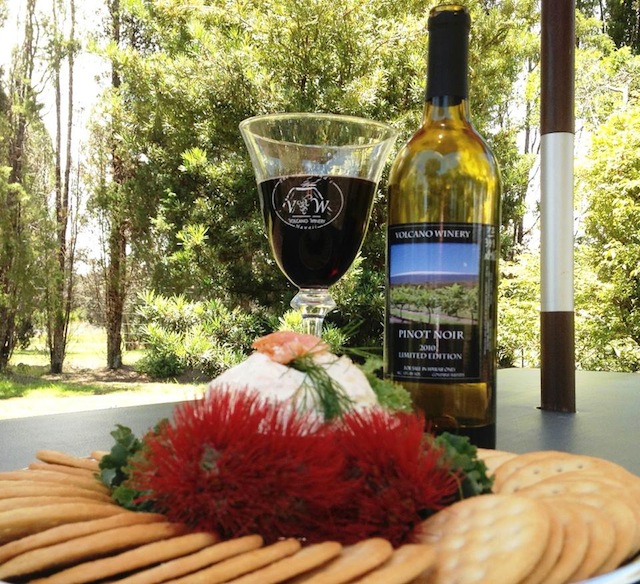
Volcano Winery Pinor Noir and house-made cream cheese blends. Photo courtesy of Volcano Winery.
A Destination Winery
As we continue walking we come to a lava tube. Despite having seen these in the nearby Volcanoes National Park, it’s interesting to view one on someone’s property. While many may view the lava tube as an annoyance leaving a gaping hole in the ground, Delwin is weaving it into future plans.
“We’re really trying to make the winery a destination with lots of activities for people,” he says. “We are blessed with a natural cave — really a collapsed lava tube — that we would like to make into a wine cellar. We are thinking we could store our oak barrels in the lava tube during the aging process and maybe even offer some barrel tastings.”
So far, they offer tours, tastings, pairings, special events and picnicking, not to mention beautiful views. The winery is also experimenting with fig and olive trees to see if they grow and produce well, adding another element to the business.
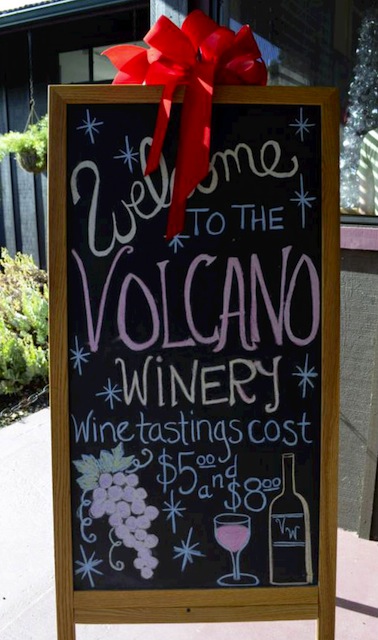
Welcome sign at Volcano Winery
Challenges
While Volcano Winery manages to create about 40,000 to 60,000 bottles of wine per year, they do face challenges when it comes to making wine. Along with having to navigate hard volcanic ground and shallow topsoil, the abundance of birds — while idyllic — also have a habit of eating the grapes. Then there’s the sulfur fumes from the nearby volcano, which typically blow in the opposite direction but can have an acid rain-like effect on their crops if the wind changes direction.
“One year we lost about 80% of our harvest,” Doc says sadly. “It usually doesn’t affect us. But when it does it can be devastating.”
Because everything on the farm is done manually, it can be difficult to produce the quantity they do with just manpower; however, as Delwin says, “It’s a labor of love!”
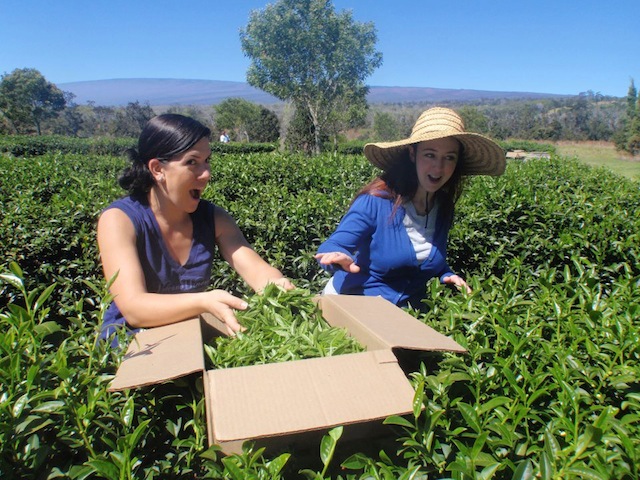
2013 tea harvest. Photo courtesy of Volcano Winery.
Tea
Interestingly, Volcano Winery also creates organic teas. While many look to Chinese teas for healing and health, Volcano Winery’s teas are void of the pollutants often found in Chinese teas, making them a delicious and curative alternative.
They currently harvest a silver needle, white and black tea, all derived from the same plant. As the tea plant “flushes” (shows new growth), the first leaf prior to opening is called silver needle because of its appearance. The silver needle, plus the first leaf that is open, is the white tea. The next older leaf plus the white tea and silver needle tea is what makes green tea, and finally any new growth that is still soft and smooth is picked for black tea.
“For the tea, we harvest everything by hand and therefore can be very particular about which tea leaves we select for silver needle, white tea and black tea,” says Delwin. “During each harvest, we start by making a pass through the tea garden and select only silver needle tea. When we think we have about one pound of tea, we then start harvesting white tea. Finally, we make a final pass and harvest only black tea.”
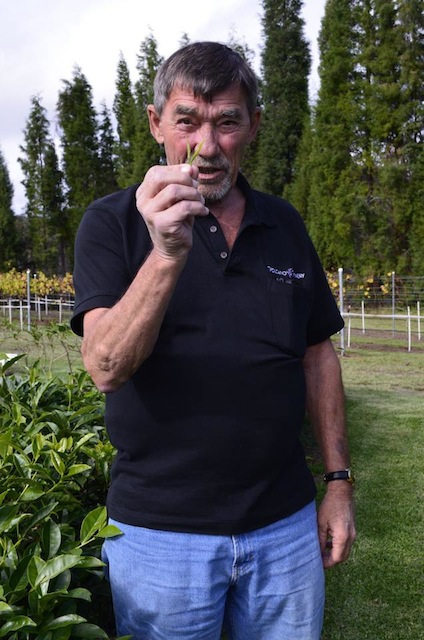
Delwin explaining how he harvests his teas
With each harvest — which they do about 10 times per year — Volcano Winery gets about 10 pounds (4.5 kilograms) of finished black tea, three pounds (1.4 kilograms) of finished white tea and ¼ pound (0.1 kilogram) of silver needle tea. While the white and silver needle tea are picked with the worker’s fingers without the aid of tools, the black tea has a special cutter with a pan attached to catch the leaves. From there, the silver needle and white tea are air dried in their kitchen, while the black tea is sent to the local Tea Hawaii to process, dry and crunch the leaves.
The Bothofs decided to plant tea in early 2005 when the idea of growing another crop in addition to the wine grapes came up. It was around this time that Dr. Zee, the USDA and the University of Hawaii‘s College of Tropical Agriculture and Human Resources (CTAHR) began experimenting with growing tea in Hawaii, and were seeing positive results.
“Volcano, with its cool nights, warm days and plentiful rainfall was identified as a region that was particularly well suited for tea cultivation,” explains Alex Wood, Volcano Winery’s field manager. “In addition to growing well in Volcano, the quality of the finished teas was very high. The more we looked into growing tea the more it became apparent it would be a good fit for our growing site and for our tasting room.”

Tea leaves at Volcano Winery
Not only did growing tea make sense from an agricultural perspective, but because it is similar to wine in terms of descriptive language when tasting, it seemed like the perfect pairing. And in late 2005 when the winery received a grant from the USDA to help with the initial costs to grow the tea, the idea became a reality, with development of their tea garden beginning in 2006.
Right now, Volcano Winery is trying to get Volcano Tea protected status, similar to how Big Island’s Kona Coffee is. In the Hawaii State Senate, there is an Act (S.B. No 2957) that recognizes the potential for Hawaiian tea to be a strong competitor in the global tea market.
“The purpose of the Act is to protect marketing of Hawaii-grown tea by requiring labeling standards that will state 100 % Hawaii –grown tea by weight,” explains Alex. ” This Act will be voted on in January 2014.”

Unusual but delicious cream cheese blends at Volcano Winery
Tasting
In the tasting room — which is also a retail store for local food products and crafts — I’m seated at a table with a decadent spread of crackers and interesting cream cheese-blends: artichoke and Parmesan; smokey salmon and fresh dill; sun-dried tomato and fresh basil; and dried cranberry and smokey bacon. Our server, Kristina, is a chipper young woman from Kentucky oozing southern charm. It’s also clear she absolutely loves wine.
“Today’s tasting will go from dry to sweet, meaning we’ll be starting with white then red then back to white,” she explains, pouring the first wine into a small cordial glass. “The first wine is a “Symphony Dry,” a dry white wine made with 100% Symphony grapes that’s great with sharp cheeses, fruits and light pastas.”
While slightly tart, it doesn’t emit a sharp pucker to the back of the jaw, but instead flavors of peach, apricot and lychee. The next wine, a namesake Pinot Noir, is also fruit forward, although subtly complex with tastes of plum and black currant. It’s made in a unique way, as instead of being barreled in oak, oak chips are added to the vat. This not only saves the winery money in terms of shipping, it also decreases the amount of time needed for aging from months to weeks (and adds a tasty oak finish).
The next wine is the medium-bodied “Volcano Red,” and is the winery’s best seller, although surprisingly nontraditional. Black currant mingles with cranberry, as white grapes mix with red. The wine is only partially made of grapes, as it’s 15% Jaboticaba berries, which add local culture by showcasing the fiery spirit of the volcano goddess Pele, with the berry skin adding a peppery spice.
“Our local fruits [are what make us unique],” Kristina says. “While many places utilize the areas they are in, our selection of Jaboticaba berries & yellow guava are very unique. Not to mention, that we are actually growing grapes on the slopes of an active volcano. This gives us a unique soil composition and growing conditions and you do pick up on these in our Estate Wines.”
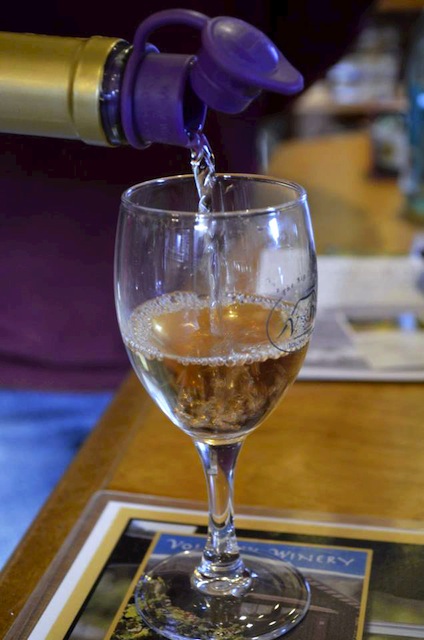
Pouring a delicious Volcano Winery wine.
A “Symphony Mele” seems sweet upon first sip — more so for me because I typically drink dry wines; however, it’s actually only 2% residual sugar. It’s made with 100% Symphony grapes, with notes of peach, apricot and lychee coating my palate. And after a “Volcanic Blush” — a crisp wine blending white grapes with Jaboticaba berries for a light bodied blush with some zing — we get to my personal favorite, a “Hawaiian Guava-Grape.” As soon as you take a sip, you know you’re in Hawaii, as 50% white wine is mixed with 50% local fermented guava. And while I’m not usually a sweet wine drinker, it transports me to a palm tree-littered beach while waking me up with a jolt of effervescence and a nutty finish.
“Welcome to the oldest form of alcohol known to man, fermented honey,” Kristina smirks, as she pulls out our first mead. It’s “Macademia Nut Honey,” a dessert wine made with 100% Hawaiian macademia nut honey. While most meads incorporate beer yeast, Volcano Winery prefers Champagne yeast for a lighter wine that’s not so thick.
“This is great served warm like a hot cider,”she continues. “It also goes well with desserts. You can paint the rim with chocolate, place it back in the fridge to set, then add in fruit and top with Champagne to offset the fruit’s sweetness. It’s the perfect drink for New Years.”
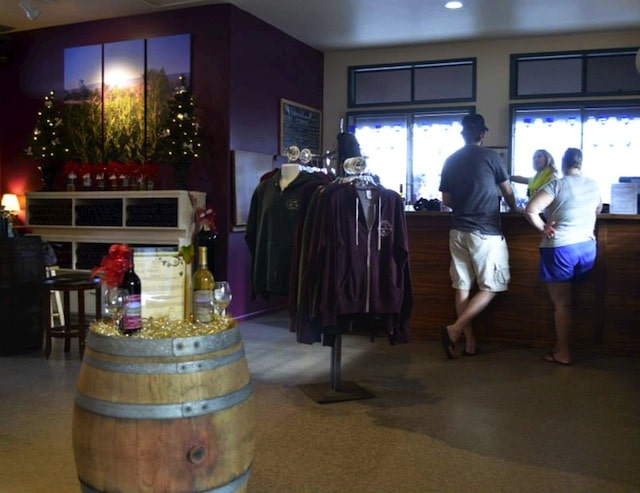
A section of Volcano Winery’s large retail store and tasting room
As I sip, I imagine the honey wine blending with chocolate for a truly decadent experience. The next mead, the “Infusion,” showcases a pairing many know well: tea and honey. The tea mead is made from 100% Hawaii ingredients, including Macadamia Nut Honey from South Kona and estate-grown black tea that reminds me of an iced tea. This wine is best served chilled as an apertif or as a refreshing drink on a sunny day. It’s also great for those wanting an energy boost, as the tea naturally transfers its caffeine to the wine, with an entire bottle being equivalent to one cup of coffee.
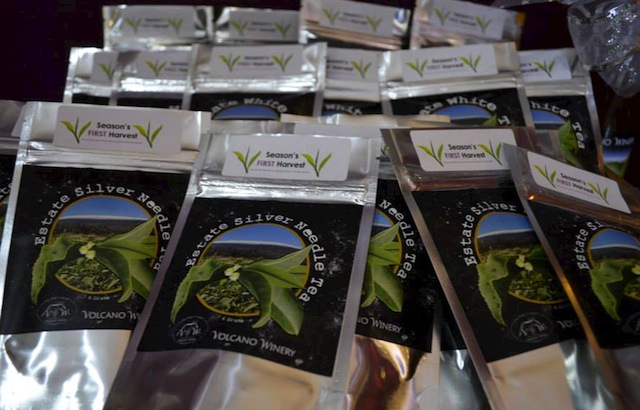
Volcano Winery Silver Needle Tea
To sober up, I also sample their estate teas, a white and a black. While the white is light and delicate with hints of vanilla and lavender that’s best served chilled to pick up its natural citrus tones, the black is also easy drinking, with notes of vanilla, caramel and truffle without the bitterness many teas emit.
By the time the tasting is through my palate feels energized and awake, not only because of the delicious flavors I’ve savored, but because it had just been introduced to tastes it had never experienced. Despite attending wine tastings on a regular basis, I’d never experienced such an interesting blending of culture and wine grapes, as local fruits, artisanal Hawaiian products and island folklore blend with traditional varietals. Delwin and Marie aren’t afraid to take risks for the sake of offering a unique experience, and in the process offering a winery that’s also a boutique destination attraction.
Tastings at Volcano Winery are $5 for seven wines or $8 for including their specialty Infusion wine. A 6-ounce glass of wine is $7. Estates teas are $2.50 each. Bottles of wine range from $16 to $70, although most are around $20. Volcano Winery is open every day of the year except Christmas from 10 am to 5:30 pm. Their address is 35 Pi’i Mauna Drive in Volcano on Big Island. You can call the winery toll free at 877-967-7772 to schedule a tour and tasting.
Featured image courtesy of leocub

Jessica Festa is the editor of the travel sites Jessie on a Journey (http://jessieonajourney.com) and Epicure & Culture (http://epicureandculture.com). Along with blogging at We Blog The World, her byline has appeared in publications like Huffington Post, Gadling, Fodor’s, Travel + Escape, Matador, Viator, The Culture-Ist and many others. After getting her BA/MA in Communication from the State University of New York at Albany, she realized she wasn’t really to stop backpacking and made travel her full time job. Some of her most memorable experiences include studying abroad in Sydney, teaching English in Thailand, doing orphanage work in Ghana, hiking her way through South America and traveling solo through Europe. She has a passion for backpacking, adventure, hiking, wine and getting off the beaten path.








